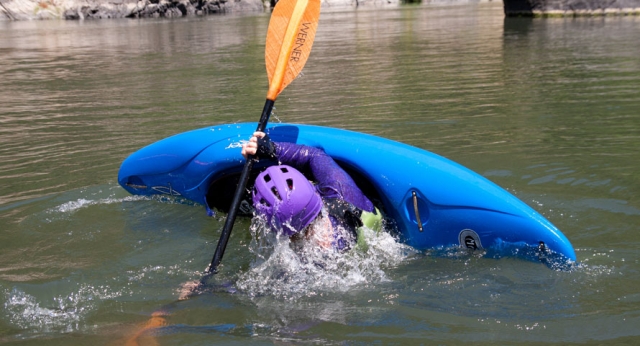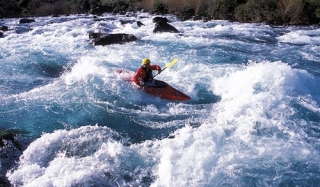- Those used in calm waters like lakes, reservoirs, or seas.
- Those designed for whitewater, named for its turbulence. These waters primarily refer to river currents, known as rapids, and are of great interest for various water sports.
1) Eskimo Roll: The most important thing is to master self-rescue techniques (the roll) and understand the difficulty of the section you’re entering.

2) Group Paddling: Never tackle a river alone—always go in a group. This is a kayaker’s golden rule. Even seasoned kayakers who know the waters well may need assistance.

3) Portaging: This means bypassing the most challenging part of the rapid (if unnavigable). If the entire stretch is too difficult, walk or climb along the bank. Avoid rapids that exceed your skill level.

4) River Reading: You’ll develop this skill with experience. It involves plotting your route through the rapid, either from the kayak or shore. Look for a "tongue" of smooth water where obstacles won’t cause issues. Observe where the current takes you and potential hazards.
5) Boof: This involves paddling hard before entering a hydraulic (hole) and giving a powerful thrust with your body just as it engulfs you. Imagine pushing the boat forward while paddling aggressively.

6) Identifying Eddies: Learn how to enter an "eddy." These are calm pools with no current—just whirlpools—where you can pause to scout or rest. They’re often created by rocks, tree roots, or the river’s flow.

Eddies are unstable; the best way to enter is by "pinning" your boat near the rock sheltering the eddy, paddling on the current side. "Pinning" means grazing the rock with your bow while leaning slightly toward it. This spins the boat 180 degrees—use your paddle for support to avoid capsizing. Pro tip: Never take your eyes off your entry point; ignore distractions until you’re ready to exit.
7) Safety: Always wear a helmet and life jacket. Fear the hydraulics? Replace it with respect—soon, you’ll want to play in them.
8) Dead Drift: Also called "passive floating," it means letting the current carry your boat while you steer lightly—go with the flow.
9) Entering the Current: Approach at 45 degrees against the flow, facing downstream. The river will spin your boat, and the action begins...
10) Ferry Glide: As if entering the current, paddle mostly on one side while using your legs to maintain direction, crossing bank to bank or eddy to eddy.












